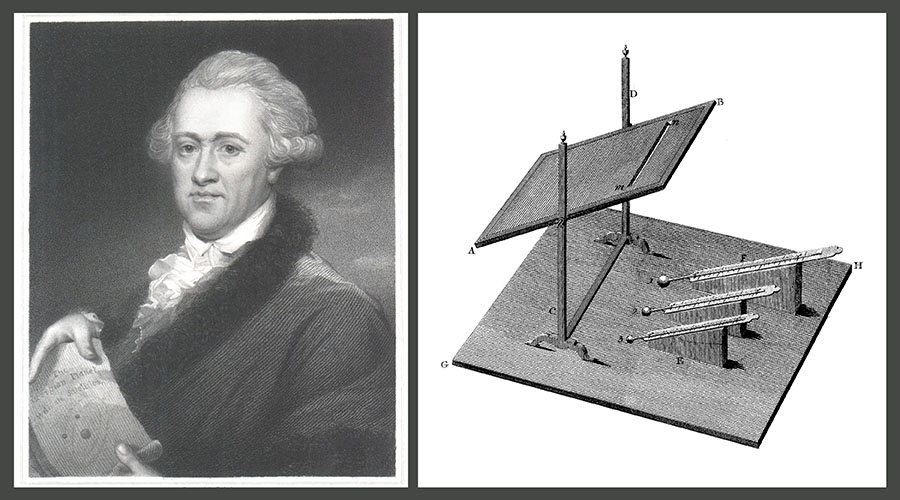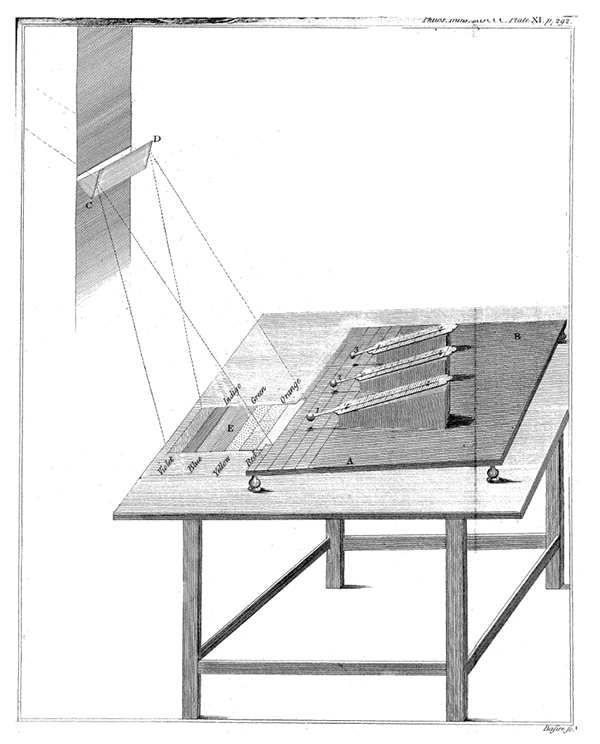March 27, 1800: William Herschel Proposes the Existence of Invisible Light
In clever experiments studying what he called “radiant heat” — what we now know as infrared light — Herschel realized there might be light we can’t see.
By Kendra Redmond | February 16, 2024

Credit: Portrait from the Smithsonian Libraries. Experiment from W. Herschel, “Investigation of the Powers of the Prismatic Colours to Heat and Illuminate Objects [...],” Philosophical Transactions of the Royal Society of London, Vol. 90 (1800), pp. 255-283.
William Herschel (left) is more famous today for discovering Uranus, but his experiments on the nature of light (right) led to groundbreaking insights.
If something is transmitted like light, refracts like light, and disperses like light, could it be light?
Already a renowned astronomer and telescope builder, William Herschel was optimizing filters for viewing the sun when, fortunately, he was distracted by this chain of thought. Over a short time, he would experimentally investigate the question, rapidly produce three papers, and conclude — incorrectly — that the answer was probably no. Nevertheless, Herschel was the first to discover infrared radiation and propose the existence of light beyond the visible range.
Herschel’s work in 1800 came after decades of respected work in astronomy — most famously, with telescopes.
Born in Hanover, Germany, in 1738 as Friedrich Wilhelm Herschel, the future astronomer had a musical upbringing. His father played oboe for the army there, and Herschel himself joined the military band. When he was 19, he moved to London, learned English, and established himself as a musician.
In the mid-1760s, Herschel moved to Bath, England, working as a musician and studying languages, math, optics, and astronomy in his spare time. In 1772, he brought his sister Caroline over from Germany and, not long after, began observing with a small reflecting telescope, reportedly even during breaks in his own performances.
While fascinated, he wasn’t satisfied. “When, in the course of time, I took up astronomy, I determined to accept nothing on faith, but to see with my own eyes everything which others had seen before me,” Hershel later wrote in a letter to the editor of the Göttingen Magazine of Science and Literacy. His telescope wasn’t big enough.
After learning to grind and polish mirrors, Herschel built his first large telescope in 1774, a reflecting telescope with a 7-foot focal length. Next came 10-foot, 20-foot, and 40-foot telescopes, often built with the help of his siblings Caroline and Alexander. The instruments were the best of their time, as were the observations Herschel made with them. After discovering Uranus in 1781, Herschel was invited by King George III to become the king’s personal astronomer.
By the turn of the century, Herschel was a renowned and prolific astronomer. But his work on the sun set the stage for his foray into a new, interesting domain: The nature of light.
At that time, visible light was simply known as light. Infrared light, ultraviolet light, and the rest of the electromagnetic spectrum had yet to be discovered. James Clerk Maxwell wouldn’t develop his theory of electromagnetic radiation for decades, and Albert Einstein wouldn’t introduce the photon for another century. The prevailing scientific question on light pitted Isaac Newton against Christiaan Huygens: Is light a stream of tiny corpuscles (particles) or a wave?
Simultaneously, scientists were delving into the nature of heat. The prevailing theory, proposed by Antoine Lavoisier, was that heat was an invisible fluid that flowed from warm objects to cold ones and filled the spaces between an object’s particles. Light and heat were seen as distinct entities, both flowing from the sun to Earth.
That is, until Herschel took up the subject. During years of solar observations, he had used pieces of colored glass to reduce the amount of light and heat coming through the telescope. While experimenting with different color combinations, he had made a surprising discovery: Certain color combinations blocked most heat but little light, while other combinations blocked most light but little heat. Furthermore, different color combinations produced different-colored images of the sun.
In a March 1800 paper he presented to the Royal Society of London, Herschel explained that these observations made him wonder whether the heating power of light varied by color. “It occurred to me, that the prismatic rays might have the power of heating bodies very unequally distributed among them,” he wrote.
Herschel tested the distribution of heat with a careful experiment. He placed a prism in the window so that sunlight passing through created a rainbow on a nearby table. Then he positioned an adjustable card with a narrow slit between the prism and table. The card blocked all but a narrow band of color from reaching the table. The bulb of one thermometer sat in the light, and another sat nearby in the card’s shade. Herschel meticulously recorded the temperature in the light and shade for bands of red, green, and violet light.
In each case, the temperature inside the light was higher than that in the shadow. Red rose highest, then green, then violet. Herschel concluded that the “radiant heat” in sunlight was being refracted by the prism according to the laws of dispersion — just like the light.
If radiant heat is unequally distributed among the colors, Herschel wondered, could illuminating power be also? That is, are objects easier to see in some colors than others? To test this, he placed small objects under a microscope. He illuminated them with only one color of light at a time (orange, yellow, green, blue, indigo, and violet), produced as in the first experiment.
By carefully rating the visibility of different objects in different colors, Herschel concluded, “The maximum of illumination lies in the brightest yellow, or palest green.” As we now know, the sensitivity of the eye peaks in exactly this range.
Reflecting on both experiments, Herschel came to a deep physical insight. Consider the spectrum from violet to red light, he told the Royal Society. Illuminating power starts low, peaks, and then decreases. But the intensity of radiant heat starts low, increases, and continues increasing. Could the peak be outside the visible range of light?

Credit: W. Herschel, “Experiments on the Refrangibility of the Invisible Rays of the Sun,” Philosophical Transactions of the Royal Society of London, Vol. 90 (1800), pp. 284-292.
The setup of one of Herschel’s experiments on light in the spring of 1800.
In experiments referred to in his March 1800 paper (and described in a follow-up paper presented shortly after), Herschel found the answer. “The full red still falls short of the maximum of heat,” he wrote. He had discovered infrared radiation.
Herschel went on to suggest that if radiant heat peaked beyond the red, “radiant heat will at least partly, if not chiefly, consist, if I may be permitted the expression, of invisible light; that is to say, of rays coming from the sun, that have such a momentum as to be unfit for vision.” It was a novel and seemingly contradictory idea — to think of something invisible as light.
The paper was received favorably, though not without criticism. However, in his third and final paper on the subject, published in two parts (one in May and one in November of the same year), Herschel backed away from his conclusion. He outlined his experimental findings on the similarities and differences between light and radiant heat and concluded that they were likely distinct entities, in part because his results were difficult to correctly interpret given the knowledge of the time. Herschel returned to observational work, making new discoveries for another 20 years before his death in 1822. But it would take generations for the scientific community to realize the full value of his brief trek into the nature of light.
Herschel’s final comments on the matter go against what we now know to be true. Even still, his insightful work laid the foundation on which scientists like Johann Wilhelm Ritter and Wilhelm Conrad Röntgen would uncover the full light spectrum, and others like James Clerk Maxwell and Max Planck would build the framework for electromagnetic radiation.
Kendra Redmond is a writer based in Minnesota.
©1995 - 2024, AMERICAN PHYSICAL SOCIETY
APS encourages the redistribution of the materials included in this newspaper provided that attribution to the source is noted and the materials are not truncated or changed.
Editor: Taryn MacKinney
March 2024 (Volume 33, Number 2)
Articles in this Issue

